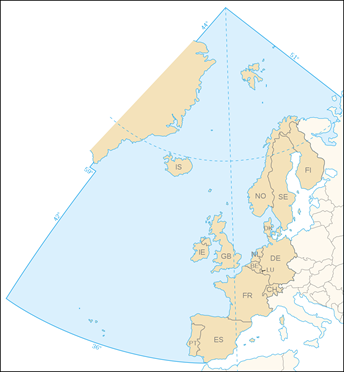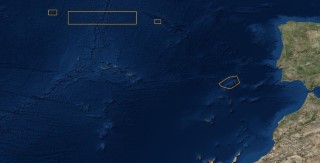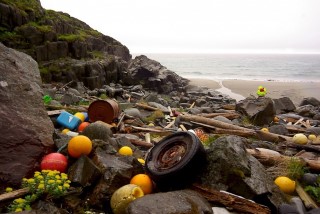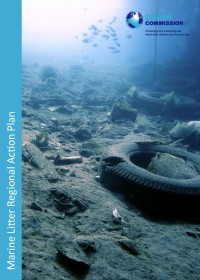OSPAR Convention
The OSPAR Convention is a regional marine convention that aims to protect the Marine Environment of the Northeast Atlantic. It is a legal mechanism through which the contracting parties that make up the OSPAR Commission cooperate to protect the marine environment of the North East Atlantic
OSPAR Convention
Breadcrumbs
- Planning and Sustainability
- Environmental Monitoring
- OSPAR Convention
OSPAR Contracting Parties are: Belgium, Denmark, Finland, France, Germany, Iceland, Ireland, the Netherlands, Norway, Portugal, Spain, Sweden, the United Kingdom, Luxembourg, Switzerland and also the European Union.
The Commission started in 1972, through the Oslo Convention which discussed the problem of dumping. Later, in 1974, the Paris Convention discussed issues related to sources of marine pollution from terrestrial origin and from the offshore industry. These two conventions were unified, updated and extended by the OSPAR Convention in 1992. The name OSPAR thus comes from the two original conventions ("OS" in Oslo and "PAR" in Paris).
The operating area of the OSPAR Convention is made up of five marine sub-regions:

The OSPAR Commission bases its Decisions and Recommendations on the following principles:
- Ecosystem approach
- The precautionary principle
- The polluter pays principle
- Best Available Techniques (BAT) and Best Environmental Practices (BEP), including clean technology.
The OSPAR convention, like other regional conventions aimed at protecting the marine environment and its biodiversity, also contributes to the objective of the Marine Strategy Framework Directive, which is to achieve good environmental status in EU marine waters by 2020.
The OSPAR Commission also has a Secretariat, whose function is to assist the Parties in pursuing the objectives of the Convention. Currently, the position of Executive Secretary is held by the Portuguese Dr.ª Susana Salvador.
The main subjects studied and analyzed by OSPAR are the following:
- Marine ecosystems and biodiversity
- Hazardous substances and eutrophication
- Human activities
- Offshore industry
- Radioactive substances
- Cross-cutting issues.
![]() Working groups with current direct participation from DGRM
Working groups with current direct participation from DGRM
DGRM is responsible for coordinating national representation at the OSPAR Convention.
I. Marine Protected Areas
II. Marine Litter
III. Intersessional Correspondence Group on the Marine Strategy Framework Directive (ICG MSFD)
I. Marine Protected Areas

Under the OSPAR Convention, Marine Protected Areas (MPAs) are spaces designated by the Contracting Parties whose objective is to protect and conserve marine species and habitats, ecosystems and the ecological processes of the marine environment. In AMP specific protection and conservation measures, or measures for the recovery and restoration of degraded areas are applied, and precautionary measures are also taken to prevent the occurrence of environmental damage in the marine environment.
At the Ministerial Meeting in Sintra, in 1998, the ministers of the OSPAR Contracting Parties agreed to establish a coherent network of Marine Protected Areas in the Northeast Atlantic. In subsequent years, this network has been built and expanded, with a greater emphasis on quality, efficiency and the practical result of the measures adopted.
As of 1 October 2016, the OSPAR network was made up of a total of 448 AMPs, including seven in marine spaces located beyond the national jurisdiction of the Contracting Parties. As a whole, the AMPs of the OSPAR network correspond to 5.9% of the respective Marine Area.
The technical data relating to each of these areas, as well as the corresponding cartographic representation, are gathered in a specific database, which is updated regularly and can be consulted on the Convention website. Currently, Portugal contributes to the OSPAR network with a total of 13 AMP, five of which are located in the marine area adjacent to the mainland, while the remaining eight are distributed in the surrounding marine region of the Azores archipelago.
II. Marine Litter

In order to fulfill this objective, the OSPAR Commission approved in 2014 (meeting held in Cascais) a Regional Action Plan (RAP) for Marine Garbage applied to the 2014-2021 period. The RAP contains 55 collective and national actions on land-based and sea-based sources, as well as education, dissemination and marine waste removal actions.
The main areas of action addressed in the RAP are: Port reception facilities; Waste from the fishing industry; Penalties for throwing garbage into the sea; 'Fishing for litter' (fishing vessels collect marine litter; Fishing gear lost and abandoned at sea; Floating garbage hotspots; Education and dissemination; Better waste management; Drainage of sewage and rainwater; Reduction of single-use items; Microplastics removal / zero pellet loss objective; Redesign of harmful products.

DGRM actively participates in several actions in the action plan for marine litter, and in particular leads actions 49 and 55:
- Action 49, relating to the presence and impact of expanded polystyrene in the marine environment and the involvement of Industry in the development of solutions to reduce its impacts.
The Interreg OceanWise project, led by DGRM, intends to respond to this RAP action.
- Action 55, for the development of regional and sub-regional maps of hotspots for the accumulation of floating marine waste.
The CleanAtlantic project, in which DGRM is a partner, includes work areas aimed at responding to this RAP action.
Get to know the OSPAR Action Plan for marine litter here.
III. Intersessional Correspondence Group on the Marine Strategy Framework Directive (ICG MSFD)
The ICG-MSFD is the Intersectional Correspondence Group on the subjects of the Marine Strategy Framework Directive, under the aegis of the OSPAR Coordination Group (CoG), which includes those responsible for the implementation of the DQEM in each Member State, representatives of the contracting parties OSPAR members who are not members of the European Union and the European Commission.
The group was formed in order to provide an informal discussion platform for the entities responsible for implementing the DQEM in the member states and, at the same time, to support the CoG in coordinating the requirements for compliance with the Directive.
![]() Related Content
Related Content
A Comissão OSPAR é o órgão decisório da Convenção e é apoiada por cinco comités, de acordo com as áreas de trabalho da OSPAR (i. biodiversidade; ii. impactes ambientais das atividades humanas; iii. eutrofização e substâncias tóxicas; iv. substâncias radioativas e v. indústria offshore), que definem e delegam em grupos de trabalho as tarefas consideradas necessárias ao cumprimento dos objetivos estratégicos da OSPAR. Os grupos intersectoriais podem ainda, por sua vez, contar com o apoio de grupos de peritos em matérias específicas. No âmbito do ICG-ML, por exemplo, foram criados vários subgrupos para dar resposta ao desenvolvimento e avaliação de indicadores para o lixo marinho nas praias, coluna de água, fundos marinhos e biota.
Compete à DGRM coordenar a representação nacional na Convenção OSPAR tendo vindo a ser feito um esforço, junto da administração e comunidade científica, para assegurar a participação de Portugal nos vários comités e grupos de trabalho da OSPAR. A delegação portuguesa na OSPAR conta assim, atualmente, com um considerável número de técnicos de um conjunto de instituições e organismos públicos da administração central (IPMA, DGPM, ICNF, APA, EMEPC), regional (DRAM, DRAAC e DRM) e local mas também de investigadores de universidades e centros de investigação. A representação portuguesa na OSPAR, por instituição, pode ser consultada aqui.
A Convenção OSPAR dispõe de um Secretariado, cuja função é assistir as Partes na prossecução dos objetivos da Convenção.
I. Áreas Marinhas Protegidas
No âmbito da Convenção OSPAR, as Áreas Marinhas Protegidas (AMP) são espaços designados pelas Partes Contratantes que têm como objetivo proteger e conservar as espécies e habitats marinhos, ecossistemas e os processos ecológicos do ambiente marinho. Nas AMP são aplicadas medidas específicas de proteção e de conservação, ou medidas de recuperação e de restauro das áreas degradadas, sendo também consideradas medidas de precaução destinadas a prevenir a ocorrência de danos ambientais no ambiente marinho.
No Encontro Ministerial de Sintra, em 1998, os ministros das Partes Contratantes OSPAR acordaram entre si o estabelecimento de uma rede coerente de Áreas Marinhas Protegidas no Atlântico Nordeste e, desde então, esta rede tem vindo a ser construída e ampliada, com crescente ênfase, na qualidade, na eficácia e no resultado prático das medidas adotadas.
Os dados técnicos referentes a cada uma destas áreas, assim como a correspondente representação cartográfica, estão reunidos numa base de dados própria, que é atualizada regularmente e que pode ser consultada aqui. Atualmente, Portugal contribui para a rede OSPAR com um total de 13 AMP, sendo que cinco estão situadas na área marinha adjacente ao território do Continente, e as restantes oito, na região marinha envolvente do arquipélago dos Açores.
II. Lixo Marinho
O objetivo OSPAR no que se refere ao lixo marinho é "prevenir a entrada de e reduzir substancialmente o lixo marinho, incluindo microplásticos, no ambiente marinho até níveis que não causem dano ao meio marinho e costeiro com o objetivo último de eliminar a entrada lixo".
Em 2014 a Comissão OSPAR aprovou (na reunião realizada em Cascais) um Plano de Ação Regional (RAP) para o Lixo Marinho. O RAP contém 55 ações coletivas e nacionais sobre fontes baseadas em terra e baseadas no mar, bem como ações de educação, divulgação e de remoção de lixo marinho. As principais áreas de ação abordadas no RAP são:
- Instalações de receção portuária;
- Desperdícios da indústria pesqueira;
- Penalizações por deitar lixo no mar;
- 'Fishing for litter' (embarcações de pesca recolhem lixo marinho;
- Artes de pesca perdidas e abandonadas no mar;
- Hotspots de lixo flutuante;
- Educação e divulgação;
- Melhor gestão de resíduos;
- Escorrência de esgotos e águas pluviais;
- Redução de itens de uso único;
- Remoção de microplásticos / objetivo zero perdas de 'pellets';
- Redesenho de produtos nocivos.
A DGRM participa ativamente em várias ações do plano de ação para o lixo marinho, e em particular lidera as ações 49 e 55:
- Ação 49, relativa à presença e impacto em ambiente marinho de poliestireno expandido e ao envolvimento da Indústria no desenvolvimento de soluções para redução dos seus impactes..
- Ação 55, para desenvolvimento de mapas regionais e sub-regionais de hotspots de acumulação de lixo marinho flutuante, inclui áreas de trabalho direcionadas para dar resposta a esta ação do RAP.
Os projetos Interreg OceanWise, liderado pela DGRM, e projeto CleanAtlantic, no qual a DGRM é parceira, pretendem dar resposta, respetivamente, às ações 49 e 55 do RAP.
Conheça aqui o atual Plano de ação OSPAR para o lixo marinho.
III. Resíduos radioativos
O Comité para os Resíduos radioativos (RSC) tem como principal objetivo promover medidas para proteger o meio marinho da poluição provocada pela descarga de substâncias radioativas. Para cumprir essas medidas, as principais ações desenvolvidas neste comité são:
- Preparação da 5ª avaliação Periódica (ICG-PEP);
- Preparação da avaliação periódica do status da qualidade (QSR) da área marítima coberta pela Convenção OSPAR;
- Metodologias para a avaliação das concentrações de radionuclídeos em ambiente marinho, no setor nuclear (ICG-CTZ);
- Criação de modelos e avaliação das concentrações dos materiais radioativos de ocorrência natural (NORM) a partir de descargas de água produzida no setor de petróleo e gás em offshore (ICG-MOD);
- Monitorização radiológica ambiental das zonas económicas exclusivas de cada parte contratante com o objetivo de controlar as descargas autorizadas bem como acidentes passados.
No cumprimento da aplicação das recomendações PARCOM 91/4, Portugal publicou, em 2020, a implementação das melhores técnicas existentes (BAT) e as melhores práticas ambientais (BEP), aplicadas na única instalação nuclear existentes no país, o reator português de investigação, instalado no Campus Tecnológico e Nuclear do Instituto Superior Técnico da Universidade de Lisboa.
No site da Agência Portuguesa do Ambiente, é possível encontrar mais informação aqui.
- Texto da Convenção OSPAR
- Decisões, Recomendações e Acordos da OSPAR



